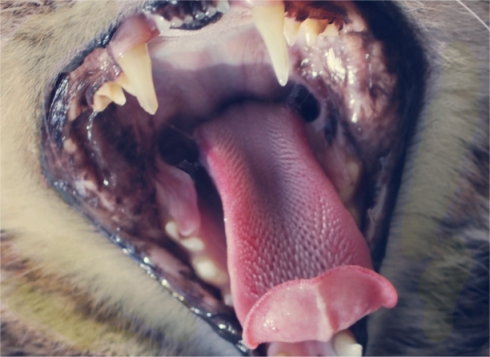Cat Dentistry - Getting to the Root of the problem
A few decades ago, the idea of giving a cat dental treatment was considered unusual – something for only the most pampered of animals. However, as cats become more a part of the families they live with, and because cats are on average living a lot longer, it is pretty certain that your cat will at some stage require dental treatment.
| This may not be immediately obvious. Cats associate pain with weakness and weakness with vulnerability. Therefore most cats are experts at concealing that something is wrong with them. (For example some people don't even realize their cat has a vision problem until the animal is virtually blind.) This is also true of dental issues. Many cats will chomp though even dry food despite having a mouth full of rotting teeth that would send a human howling to the dentist. |
Though the cat may hide it, this does not mean she is not suffering. Even if the cat is more stoical about it, bad teeth are as painful for a cat as they are for a human. Signs that a cat might have dental issues include drooling, bad breath, sensitivity to being touched on the jaw (shown by, for example chattering teeth), and the cat becoming a picky eater. Sometimes direct examination will show blackened or fractured teeth. Not only are dental problems painful for the cat, but they can also lead to health issues elsewhere in the body if a tooth infection spreads.
You can help to keep your cat's mouth healthy by regular cleaning and giving your cat 'dental' biscuits which help to fight tartar (see Cat dental care). However, even if the vet regularly cleans and polishes your cat's teeth, if the cat is over five years old there is at least a 70% chance that dental intervention will be required at some point.

The most common problem is something called an odontoclastic resorptive lesion (ORL). Some cats, such as Persians, are particularly vulnerable to this, but all cats can have this problem, and the lesions have been found in the skeletons of cats from hundreds of years ago.
When a cat develops a dental problem – for example a cavity – she loses dentine, the protective hard shell of the tooth. In cats this may start the ORL process. Basically, the tooth starts getting re-absorbed back into the jaw. This is a progressive problem and one which causes the cat a great deal of discomfort, because the growth can make chewing difficult and also the loss of dentine can cause a tooth to fracture. In some teeth, such as the canines, the pulp inside the tooth goes right to the tip, so a fracture is particularly painful.
The dentist cannot simply put a crown on the injured tooth, because re-absorption and growth will continue right under the crown, so more drastic measures are required. In the past, this meant removing the tooth. While this works well in the early stages of ORL, it is more problematic later because by then the roots might have been so fused with the jaw that the dentist will be searching for a root to remove that is not in fact there. (Feline teeth have relatively short roots compared to dogs and humans, even taking their smaller size into account.)
As a result when ORL is advanced, the feline dentist might instead do a 'crown amputation'. This consists of amputating that part of the diseased tooth that is above the jaw-line, and leaving the lower part to be absorbed naturally. Often this process works very well, and even cats with a full-mouth crown amputation have been known to happily crunch through biscuits a few months later.
Whether to do an extraction or a crown amputation is a tricky call for the feline dentist, and generally only decided after full x-rays and examination. If there is a chance of peridontal disease (infection or inflammation of the gum) then a crown amputation can cause as many problems as it resolves. On the other hand, the extraction of a mostly-absorbed tooth is also problematic. One thing most feline dentists agree on – crowns and fillings, which work so well in human mouths, are seldom successful in cats. On the other hand, feline flesh knits together uncommonly well, so after extraction or crown amputation most cats are attacking their food with relish again after only a few days or weeks.

